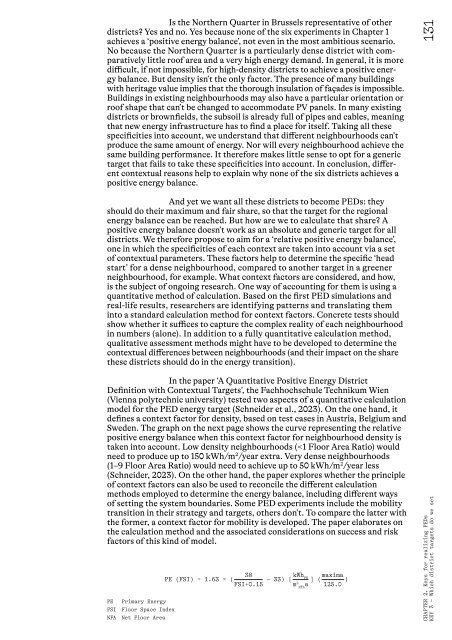Powering the energy transition at the district level_Cities4PEDs_AWB_final
Create successful ePaper yourself
Turn your PDF publications into a flip-book with our unique Google optimized e-Paper software.
Is <strong>the</strong> Nor<strong>the</strong>rn Quarter in Brussels represent<strong>at</strong>ive of o<strong>the</strong>r<br />
<strong>district</strong>s? Yes and no. Yes because none of <strong>the</strong> six experiments in Chapter 1<br />
achieves a ‘positive <strong>energy</strong> balance’, not even in <strong>the</strong> most ambitious scenario.<br />
No because <strong>the</strong> Nor<strong>the</strong>rn Quarter is a particularly dense <strong>district</strong> with compar<strong>at</strong>ively<br />
little roof area and a very high <strong>energy</strong> demand. In general, it is more<br />
difficult, if not impossible, for high-density <strong>district</strong>s to achieve a positive <strong>energy</strong><br />
balance. But density isn’t <strong>the</strong> only factor. The presence of many buildings<br />
with heritage value implies th<strong>at</strong> <strong>the</strong> thorough insul<strong>at</strong>ion of façades is impossible.<br />
Buildings in existing neighbourhoods may also have a particular orient<strong>at</strong>ion or<br />
roof shape th<strong>at</strong> can’t be changed to accommod<strong>at</strong>e PV panels. In many existing<br />
<strong>district</strong>s or brownfields, <strong>the</strong> subsoil is already full of pipes and cables, meaning<br />
th<strong>at</strong> new <strong>energy</strong> infrastructure has to find a place for itself. Taking all <strong>the</strong>se<br />
specificities into account, we understand th<strong>at</strong> different neighbourhoods can’t<br />
produce <strong>the</strong> same amount of <strong>energy</strong>. Nor will every neighbourhood achieve <strong>the</strong><br />
same building performance. It <strong>the</strong>refore makes little sense to opt for a generic<br />
target th<strong>at</strong> fails to take <strong>the</strong>se specificities into account. In conclusion, different<br />
contextual reasons help to explain why none of <strong>the</strong> six <strong>district</strong>s achieves a<br />
positive <strong>energy</strong> balance.<br />
131<br />
And yet we want all <strong>the</strong>se <strong>district</strong>s to become PEDs: <strong>the</strong>y<br />
should do <strong>the</strong>ir maximum and fair share, so th<strong>at</strong> <strong>the</strong> target for <strong>the</strong> regional<br />
<strong>energy</strong> balance can be reached. But how are we to calcul<strong>at</strong>e th<strong>at</strong> share? A<br />
positive <strong>energy</strong> balance doesn’t work as an absolute and generic target for all<br />
<strong>district</strong>s. We <strong>the</strong>refore propose to aim for a ‘rel<strong>at</strong>ive positive <strong>energy</strong> balance’,<br />
one in which <strong>the</strong> specificities of each context are taken into account via a set<br />
of contextual parameters. These factors help to determine <strong>the</strong> specific ‘head<br />
start’ for a dense neighbourhood, compared to ano<strong>the</strong>r target in a greener<br />
neighbourhood, for example. Wh<strong>at</strong> context factors are considered, and how,<br />
is <strong>the</strong> subject of ongoing research. One way of accounting for <strong>the</strong>m is using a<br />
quantit<strong>at</strong>ive method of calcul<strong>at</strong>ion. Based on <strong>the</strong> first PED simul<strong>at</strong>ions and<br />
real-life results, researchers are identifying p<strong>at</strong>terns and transl<strong>at</strong>ing <strong>the</strong>m<br />
into a standard calcul<strong>at</strong>ion method for context factors. Concrete tests should<br />
show whe<strong>the</strong>r it suffices to capture <strong>the</strong> complex reality of each neighbourhood<br />
in numbers (alone). In addition to a fully quantit<strong>at</strong>ive calcul<strong>at</strong>ion method,<br />
qualit<strong>at</strong>ive assessment methods might have to be developed to determine <strong>the</strong><br />
contextual differences between neighbourhoods (and <strong>the</strong>ir impact on <strong>the</strong> share<br />
<strong>the</strong>se <strong>district</strong>s should do in <strong>the</strong> <strong>energy</strong> <strong>transition</strong>).<br />
In <strong>the</strong> paper ‘A Quantit<strong>at</strong>ive Positive Energy District<br />
Definition with Contextual Targets’, <strong>the</strong> Fachhochschule Technikum Wien<br />
(Vienna polytechnic university) tested two aspects of a quantit<strong>at</strong>ive calcul<strong>at</strong>ion<br />
model for <strong>the</strong> PED <strong>energy</strong> target (Schneider et al., 2023). On <strong>the</strong> one hand, it<br />
defines a context factor for density, based on test cases in Austria, Belgium and<br />
Sweden. The graph on <strong>the</strong> next page shows <strong>the</strong> curve representing <strong>the</strong> rel<strong>at</strong>ive<br />
positive <strong>energy</strong> balance when this context factor for neighbourhood density is<br />
taken into account. Low density neighbourhoods (

















